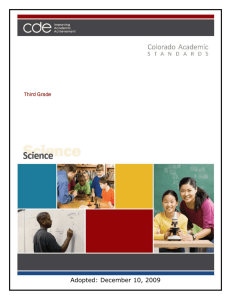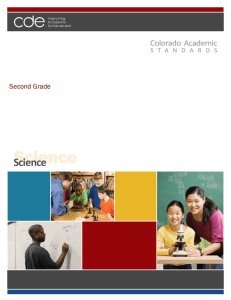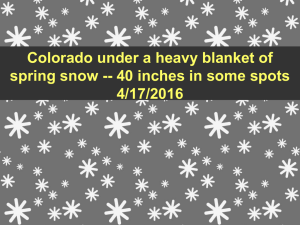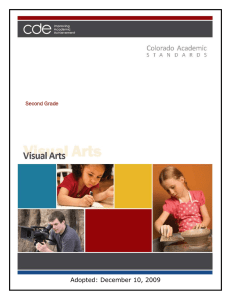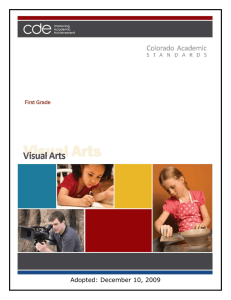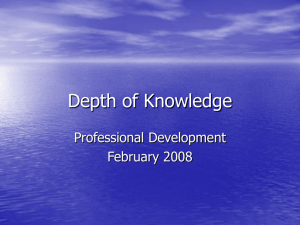Adopted: December 10, 2009 First Grade
advertisement
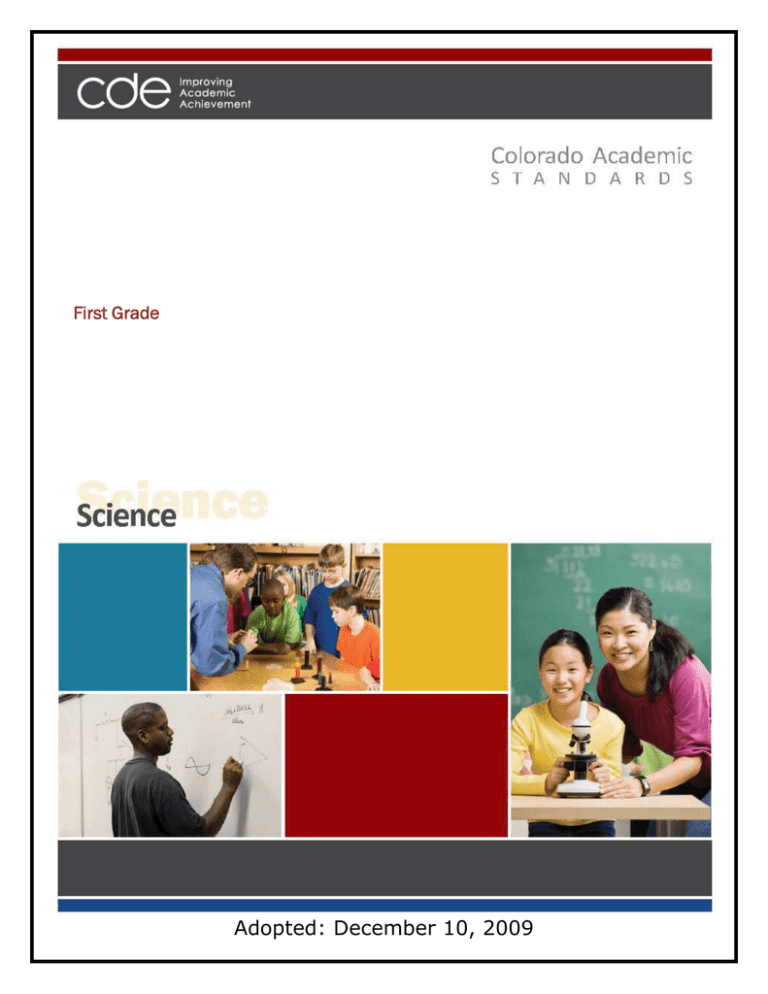
First Grade Adopted: December 10, 2009 Colorado Academic Standards Science “Science is facts; just as houses are made of stone, so is science made of facts; but a pile of stones is not a house, and a collection of facts is not necessarily science.” --Jules Henri Poincaré (1854-1912) French mathematician. ~~~~~~~~~~~~~~~~~~~~~~~~~~~~~~~~~~ High expectations in education are essential for the U.S. to continue as a world leader in the 21st century. In order to be successful in postsecondary education, the workforce, and in life, students need a rigorous, age-appropriate set of standards that include finding and gathering information, critical thinking, and reasoning skills to evaluate information, and use information in social and cultural contexts. Students must learn to comprehend and process information, analyze and draw conclusions, and apply the results to everyday life. A quality science education embodies 21 st century skills and postsecondary and workforce readiness by teaching students critical skills and thought processes to meet the challenges of today’s world. Scientifically literate graduates will help to ensure Colorado’s economic vitality by encouraging the development of research and technology, managing and preserving our environmental treasures, and caring for the health and well-being of our citizens. Science is both a body of knowledge that represents the current understanding of natural systems, and the process whereby that body of knowledge has been established and is continually extended, refined, and revised. Because science is both the knowledge of the natural world and the processes that have established this knowledge, science education must address both of these aspects. At a time when pseudo-scientific ideas and outright fraud are becoming more common place, developing the skepticism and critical thinking skills of science gives students vital skills needed to make informed decisions about their health, the environment, and other scientific issues facing society. A major aspect of science is the continual interpretation of evidence. All scientific ideas constantly are being challenged by new evidence and are evolving to fit the new evidence. Students must understand the collaborative social processes that guide these changes so they can reason through and think critically about popular scientific information, and draw valid conclusions based on evidence, which often is limited. Imbedded in the cognitive process, students learn and apply the social and cultural skills expected of all citizens in school and in the workplace. For example, during class activities, laboratory exercises, and projects, students learn and practice self-discipline, collaboration, and working in groups. The Colorado Academic Standards in science represent what all Colorado students should know and be able to do in science as a result of their preschool through twelfth-grade science education. Specific expectations are given for students who complete each grade from preschool through eighth grade and for high school. These standards outline the essential level of science content knowledge and the application of the skills needed by all Colorado citizens to participate productively in our increasingly global, information-driven society. CDE: 1st Grade Science Adopted: December 10, 2009 Page 2 of 16 Standards Organization and Construction As the subcommittee began the revision process to improve the existing standards, it became evident that the way the standards information was organized, defined, and constructed needed to change from the existing documents. The new design is intended to provide more clarity and direction for teachers, and to show how 21 st century skills and the elements of school readiness and postsecondary and workforce readiness indicators give depth and context to essential learning. The “Continuum of State Standards Definitions” section that follows shows the hierarchical order of the standards components. The “Standards Template” section demonstrates how this continuum is put into practice. The elements of the revised standards are: Prepared Graduate Competencies: The preschool through twelfth-grade concepts and skills that all students who complete the Colorado education system must master to ensure their success in a postsecondary and workforce setting. Standard: The topical organization of an academic content area. High School Expectations: The articulation of the concepts and skills of a standard that indicates a student is making progress toward being a prepared graduate. What do students need to know in high school? Grade Level Expectations: The articulation (at each grade level), concepts, and skills of a standard that indicate a student is making progress toward being ready for high school. What do students need to know from preschool through eighth grade? Evidence Outcomes: The indication that a student is meeting an expectation at the mastery level. How do we know that a student can do it? 21st Century Skills and Readiness Competencies: Includes the following: Inquiry Questions: Sample questions are intended to promote deeper thinking, reflection and refined understandings precisely related to the grade level expectation. Relevance and Application: Examples of how the grade level expectation is applied at home, on the job or in a realworld, relevant context. Nature of the Discipline: The characteristics and viewpoint one keeps as a result of mastering the grade level expectation. CDE: 1st Grade Science Adopted: December 10, 2009 Page 3 of 16 Continuum of State Standards Definitions Prepared Graduate Competency The preschool through twelfth-grade concepts and skills that all students who complete the Colorado education system must master to ensure their success in a postsecondary and workforce setting. Standards Standards are the topical organization of an academic content area. P-8 High School Grade Level Expectations Expectations articulate, at each grade level, the knowledge and skills of a standard that indicates a student is making progress toward high school. What do students need to know? Evidence Outcomes Evidence outcomes are the indication that a student is meeting an expectation at the mastery level. How do we know that a student can do it? 21st Century and PWR Skills Inquiry Questions: Sample questions intended to promote deeper thinking, reflection and refined understandings precisely related to the grade level expectation. Relevance and Application: Examples of how the grade level expectation is applied at home, on the job or in a real-world, relevant context. High School Expectations Expectations articulate the knowledge and skills of a standard that indicates a student is making progress toward being a prepared graduate. What do students need to know? Evidence Outcomes Evidence outcomes are the indication that a student is meeting an expectation at the mastery level. How do we know that a student can do it? Nature of the Discipline: The characteristics and viewpoint one keeps as a result of mastering the grade level expectation. CDE: 1st Grade Science Adopted: December 10, 2009 21st Century and PWR Skills Inquiry Questions: Sample questions intended to promote deeper thinking, reflection and refined understandings precisely related to the grade level expectation. Relevance and Application: Examples of how the grade level expectation is applied at home, on the job or in a real-world, relevant context. Nature of the Discipline: The characteristics and viewpoint one keeps as a result of mastering the grade level expectation. Page 4 of 16 STANDARDS TEMPLATE Content Area: NAME OF CONTENT AREA Standard: The topical organization of an academic content area. Prepared Graduates: The preschool through twelfth-grade concepts and skills that all students who complete the Colorado education system must master to ensure their success in a postsecondary and workforce setting. High School and Grade Level Expectations Concepts and skills students master: Grade Level Expectation: High Schools: The articulation of the concepts and skills of a standard that indicates a student is making progress toward being a prepared graduate. Grade Level Expectations: The articulation, at each grade level, the concepts and skills of a standard that indicates a student is making progress toward being ready for high school. What do students need to know? Evidence Outcomes 21st Century Skills and Readiness Competencies Students can: Inquiry Questions: Evidence outcomes are the indication that a student is meeting an expectation at the mastery level. Sample questions intended to promote deeper thinking, reflection and refined understandings precisely related to the grade level expectation. How do we know that a student can do it? Relevance and Application: Examples of how the grade level expectation is applied at home, on the job or in a real-world, relevant context. Nature of the Discipline: The characteristics and viewpoint one keeps as a result of mastering the grade level expectation. Colorado Department of Education: 1st Grade Science Adopted: December 10, 2009 Page 5 of 16 Prepared Graduate Competencies in Science The preschool through twelfth-grade concepts and skills that all students who complete the Colorado education system must master to ensure their success in a postsecondary and workforce setting. Prepared Graduates: Observe, explain, and predict natural phenomena governed by Newton's laws of motion, acknowledging the limitations of their application to very small or very fast objects Apply an understanding of atomic and molecular structure to explain the properties of matter, and predict outcomes of chemical and nuclear reactions Apply an understanding that energy exists in various forms, and its transformation and conservation occur in processes that are predictable and measurable Analyze the relationship between structure and function in living systems at a variety of organizational levels, and recognize living systems’ dependence on natural selection Explain and illustrate with examples how living systems interact with the biotic and abiotic environment Analyze how various organisms grow, develop, and differentiate during their lifetimes based on an interplay between genetics and their environment Explain how biological evolution accounts for the unity and diversity of living organisms Describe and interpret how Earth's geologic history and place in space are relevant to our understanding of the processes that have shaped our planet Evaluate evidence that Earth’s geosphere, atmosphere, hydrosphere, and biosphere interact as a complex system Describe how humans are dependent on the diversity of resources provided by Earth and Sun CDE: 1st Grade Science Adopted: December 10, 2009 Page 6 of 16 Standards in Science Standards are the topical organization of an academic content area. The three standards of science are: 1. Physical Science Students know and understand common properties, forms, and changes in matter and energy. 2. Life Science Students know and understand the characteristics and structure of living things, the processes of life, and how living things interact with each other and their environment. 3. Earth Systems Science Students know and understand the processes and interactions of Earth's systems and the structure and dynamics of Earth and other objects in space. Science Grade Level Expectations at a Glance Standard Grade Level Expectation First Grade 1. Physical Science 2. Life Science 1. Solids and liquids have unique properties that distinguish them 1. Offspring have characteristics that are similar to but not exactly like their parents’ characteristics An organism is a living thing that has physical characteristics to help it survive Earth’s materials can be compared and classified based on their properties 2. 3. Earth Systems Science 1. CDE: 1st Grade Science Adopted: December 10, 2009 Page 7 of 16 21st Century Skills and Readiness Competencies in Science Colorado's Description of 21st Century Skills Colorado's description of 21st century skills is a synthesis of the essential abilities students must apply in our rapidly changing world. Today’s students need a repertoire of knowledge and skills that are more diverse, complex, and integrated than any previous generation. These skills do not stand alone in the standards, but are woven into the evidence outcomes, inquiry questions, and application and are within the nature of science. Science inherently demonstrates each of Colorado’s 21st century skills, as follows: Critical Thinking and Reasoning Science requires students to analyze evidence and draw conclusions based on that evidence. Scientific investigation involves defining problems and designing studies to test hypotheses related to those problems. In science, students must justify and defend scientific explanations and distinguish between correlation and causation. Information Literacy Understanding science requires students to research current ideas about the natural world. Students must be able to distinguish fact from opinion and truth from fantasy. Science requires a degree of skepticism because the ideas of science are subject to change. Science students must be able to understand what constitutes reliable sources of information and how to validate those sources. One key to science is understanding that converging different lines of evidence from multiple sources strengthens a scientific conclusion. Collaboration Science students must be able to listen to others’ ideas, and engage in scientific dialogs that are based on evidence – not opinion. These types of conversations allow them to compare and evaluate the merit of different ideas. The peer review process helps to ensure the validity of scientific explanations. Self-Direction Students in science must have persistence and perseverance when exploring scientific concepts. Students must generate their own questions, and design investigations to find the answers. Students must be open to revising and redefining their thinking based on evidence. Invention Designing investigations and engineering new products involves a large degree of invention. Scientists and engineers often have to think “outside the box” as they push the limits of our current knowledge. They must learn from their failures to take the next steps in understanding. Science students also must integrate ideas from multiple disciplines to formulate an understanding of the natural world. In addition to using invention to design investigations, scientists also use findings from investigations to help them to invent new products. CDE: 1st Grade Science Adopted: December 10, 2009 Page 8 of 16 Colorado’s Description for School Readiness (Adopted by the State Board of Education, December 2008) School readiness describes both the preparedness of a child to engage in and benefit from learning experiences, and the ability of a school to meet the needs of all students enrolled in publicly funded preschools or kindergartens. School readiness is enhanced when schools, families, and community service providers work collaboratively to ensure that every child is ready for higher levels of learning in academic content. Colorado’s Description of Postsecondary and Workforce Readiness (Adopted by the State Board of Education, June 2009) Postsecondary and workforce readiness describes the knowledge, skills, and behaviors essential for high school graduates to be prepared to enter college and the workforce and to compete in the global economy. The description assumes students have developed consistent intellectual growth throughout their high school career as a result of academic work that is increasingly challenging, engaging, and coherent. Postsecondary education and workforce readiness assumes that students are ready and able to demonstrate the following without the need for remediation: Critical thinking and problem-solving; finding and using information/information technology; creativity and innovation; global and cultural awareness; civic responsibility; work ethic; personal responsibility; communication; and collaboration. How These Skills and Competencies are Embedded in the Revised Standards Three themes are used to describe these important skills and competencies and are interwoven throughout the standards: inquiry questions; relevance and application; and the nature of each discipline. These competencies should not be thought of stand-alone concepts, but should be integrated throughout the curriculum in all grade levels. Just as it is impossible to teach thinking skills to students without the content to think about, it is equally impossible for students to understand the content of a discipline without grappling with complex questions and the investigation of topics. Inquiry Questions – Inquiry is a multifaceted process requiring students to think and pursue understanding. Inquiry demands that students (a) engage in an active observation and questioning process; (b) investigate to gather evidence; (c) formulate explanations based on evidence; (d) communicate and justify explanations, and; (e) reflect and refine ideas. Inquiry is more than hands-on activities; it requires students to cognitively wrestle with core concepts as they make sense of new ideas. Relevance and Application – The hallmark of learning a discipline is the ability to apply the knowledge, skills, and concepts in real-world, relevant contexts. Components of this include solving problems, developing, adapting, and refining solutions for the betterment of society. The application of a discipline, including how technology assists or accelerates the work, enables students to more fully appreciate how the mastery of the grade level expectation matters after formal schooling is complete. Nature of Discipline – The unique advantage of a discipline is the perspective it gives the mind to see the world and situations differently. The characteristics and viewpoint one keeps as a result of mastering the grade level expectation is the nature of the discipline retained in the mind’s eye. CDE: 1st Grade Science Adopted: December 10, 2009 Page 9 of 16 1. Physical Science Students know and understand common properties, forms and changes in matter and energy. Prepared Graduates The preschool through twelfth-grade concepts and skills that all students who complete the Colorado education system must master to ensure their success in a postsecondary and workforce setting. Prepared Graduate Competencies in the Physical Science standard: Observe, explain, and predict natural phenomena governed by Newton's laws of motion, acknowledging the limitations of their application to very small or very fast objects Apply an understanding of atomic and molecular structure to explain the properties of matter, and predict outcomes of chemical and nuclear reactions Apply an understanding that energy exists in various forms, and its transformation and conservation occur in processes that are predictable and measurable Content Area: Science Standard: 1. Physical Science Prepared Graduates: Apply an understanding of atomic and molecular structure to explain the properties of matter, and predict outcomes of chemical and nuclear reactions Grade Level Expectation: First Grade Concepts and skills students master: 1. Solids and liquids have unique properties that distinguish them Evidence Outcomes 21st Century Skills and Readiness Competencies Colorado Department of Education: 1st Grade Science Adopted: December 10, 2009 Page 10 of 16 Students can: a. Analyze and interpret observations about solids and liquids and their unique properties (DOK 1-3) b. Identify the similarities and differences of two or more groups of solids or liquids (DOK 1-2) c. Classify solids and liquids based on their properties, and justify your choice based on evidence (DOK 1-3) Inquiry Questions: 1. What do all liquids have in common? What are some differences they can have and still be considered liquids? 2. What do all solids have in common? What are some differences they can have and still be considered solids? 3. What properties of liquids can be used to sort them? 4. What properties of solids can be used to sort them? Relevance and Application: 1. The properties of solids and liquids help us understand how to use matter. For example, we not build a bridge out of tissue because it is not strong enough. 2. There are practical reasons for sorting liquids or solids. Nature of Science: 1. Share results of experiments with others. (DOK 1-2) 2. Recognize that observations are an important part of science. (DOK 1) 3. Conduct collaborative experiments. (DOK 2-4) Colorado Department of Education: 1st Grade Science Adopted: December 10, 2009 Page 11 of 16 2. Life Science Students know and understand the characteristics and structure of living things, the processes of life and how living things interact with each other and their environment. Prepared Graduates The preschool through twelfth-grade concepts and skills that all students who complete the Colorado education system must master to ensure their success in a postsecondary and workforce setting. Prepared Graduate Competencies in the Life Science standard: Analyze the relationship between structure and function in living systems at a variety of organizational levels, and recognize living systems’ dependence on natural selection Explain and illustrate with examples how living systems interact with the biotic and abiotic environment Analyze how various organisms grow, develop, and differentiate during their lifetimes based on an interplay between genetics and their environment Explain how biological evolution accounts for the unity and diversity of living organisms Colorado Department of Education: 1st Grade Science Adopted: December 10, 2009 Page 12 of 16 Content Area: Science Standard: 2. Life Science Prepared Graduates: Analyze how various organisms grow, develop, and differentiate during their lifetimes based on an interplay between genetics and their environment Grade Level Expectation: First Grade Concepts and skills students master: 1. Offspring have characteristics that are similar to but not exactly like their parents’ characteristics Evidence Outcomes 21st Century Skills and Readiness Competencies Students can: a. Use evidence to analyze similarities and differences between parents and offspring in a variety of organisms including both plants and animals (DOK 1-2) b. Analyze and interpret data regarding the similarities and differences between parents and offspring (DOK 1-2) c. Question peers about evidence used in developing ideas about similarities and differences between parents and offspring (DOK 1-2) d. Interpret information represented in pictures, illustrations, and simple charts (DOK 1-2) Inquiry Questions: 1. How are you like your parents? 2. In what ways do offspring resemble their parents? Relevance and Application: 1. Diversity – or variation – exists within populations of living organisms. 2. Family photographs often reveal similar physical traits. 3. Parents eye color can be different their child’s. Nature of Science: 1. Compare and contrast data, recognizing that this is a process scientists would do in their work. (DOK 1-2) 2. Question peers about the evidence used in developing their ideas about the similarities and differences between parents and offspring. (DOK 2) Colorado Department of Education: 1st Grade Science Adopted: December 10, 2009 Page 13 of 16 Content Area: Science Standard: 2. Life Science Prepared Graduates: Analyze the relationship between structure and function in living systems at a variety of organizational levels, and recognize living systems’ dependence on natural selection Grade Level Expectation: First Grade Concepts and skills students master: 2. An organism is a living thing that has physical characteristics to help it survive Evidence Outcomes 21st Century Skills and Readiness Competencies Students can: a. Identify organisms and use evidence based scientific explanations for classifying them into groups (DOK 13) b. Analyze and interpret data about the needs of plants and animals (DOK 12) c. Use direct observations and other evidence to support ideas concerning physical characteristics that help plants and animals survive (DOK 1-3) Inquiry Questions: 1. How do the needs of plants and animals differ? 2. What helps a specific plant or animal survive? Relevance and Application: 1. Animals and plants have characteristics that help them survive in the local environment. For example, the thick fur of animals such as raccoons, bears, and mule deer helps them survive the cold winters in Colorado. 2. A living thing can be harmed if needed resources are lacking. Nature of Science: 1. Ask testable questions about the needs of an organism. (DOK 2) 2. Predict the outcome for an organism if a need is removed. (DOK 2-3) Colorado Department of Education: 1st Grade Science Adopted: December 10, 2009 Page 14 of 16 3. Earth Systems Science Students know and understand the processes and interactions of Earth's systems and the structure and dynamics of Earth and other objects in space. Prepared Graduates: The preschool through twelfth-grade concepts and skills that all students who complete the Colorado education system must master to ensure their success in a postsecondary and workforce setting. Prepared Graduate Competencies in the Earth Systems Science standard: Describe and interpret how Earth's geologic history and place in space are relevant to our understanding of the processes that have shaped our planet Evaluate evidence that Earth’s geosphere, atmosphere, hydrosphere, and biosphere interact as a complex system Describe how humans are dependent on the diversity of resources provided by Earth and Sun Colorado Department of Education: 1st Grade Science Adopted: December 10, 2009 Page 15 of 16 Content Area: Science Standard: 3. Earth Systems Science Prepared Graduates: Describe how humans are dependent on the diversity of resources provided by Earth and Sun Grade Level Expectation: First Grade Concepts and skills students master: 1. Earth’s materials can be compared and classified based on their properties Evidence Outcomes 21st Century Skills and Readiness Competencies Students can: a. Identify and represent similarities and differences such as the texture, size, color, and shape of various materials on Earth (DOK 1-2) b. Sort, group, and classify Earth’s materials based on observations and explorations (DOK 1-2) c. Make predictions about how a material on Earth might be useful based on its properties (DOK 1-3) d. Communicate ideas about the differences between soils from different places (DOK 1-2) e. Use a variety of tools to observe, analyze, record, and compare Earth’s materials (DOK 1-2) f. Analyze the impact of reducing, reusing, and recycling various materials (DOK 1-3) Inquiry Questions: 1. How are various materials on Earth similar and different? 2. How do the properties of various materials on Earth affect the way we can use them? 3. How does soil differ from different places? Relevance and Application: 1. Humans use natural resources in our daily lives and in a variety of ways. For example, wood for building and furniture. 2. There are limits on resources and materials extracted from the natural environment. Nature of Science: 1. The same materials can be sorted in a number of ways based on different characteristics. (DOK 1-2) 2. Scientists make predictions based on what they know. (DOK 1) Colorado Department of Education: 1st Grade Science Adopted: December 10, 2009 Page 16 of 16 Colorado Department of Education Office of Standards and Instructional Support 201 East Colfax Ave. • Denver, CO 80203 Science Content Specialist: XXXXXX (XXXXXX@cde.state.co.us) http://www.cde.state.co.us/CoScience/StateStandards.asp


